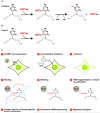Identification of direct targets and modified bases of RNA cytosine methyltransferases
- PMID: 23604283
- PMCID: PMC3791587
- DOI: 10.1038/nbt.2566
Identification of direct targets and modified bases of RNA cytosine methyltransferases
Abstract
The extent and biological impact of RNA cytosine methylation are poorly understood, in part owing to limitations of current techniques for determining the targets of RNA methyltransferases. Here we describe 5-azacytidine-mediated RNA immunoprecipitation (Aza-IP), a technique that exploits the covalent bond formed between an RNA methyltransferase and the cytidine analog 5-azacytidine to recover RNA targets by immunoprecipitation. Targets are subsequently identified by high-throughput sequencing. When applied in a human cell line to the RNA methyltransferases DNMT2 and NSUN2, Aza-IP enabled >200-fold enrichment of tRNAs that are known targets of the enzymes. In addition, it revealed many tRNA and noncoding RNA targets not previously associated with NSUN2. Notably, we observed a high frequency of C→G transversions at the cytosine residues targeted by both enzymes, allowing identification of the specific methylated cytosine(s) in target RNAs. Given the mechanistic similarity of RNA cytosine methyltransferases, Aza-IP may be generally applicable for target identification.
Figures




Similar articles
-
Transcriptome-wide target profiling of RNA cytosine methyltransferases using the mechanism-based enrichment procedure Aza-IP.Nat Protoc. 2014 Feb;9(2):337-61. doi: 10.1038/nprot.2014.014. Epub 2014 Jan 16. Nat Protoc. 2014. PMID: 24434802
-
Experimental Approaches for Target Profiling of RNA Cytosine Methyltransferases.Methods Enzymol. 2015;560:273-96. doi: 10.1016/bs.mie.2015.03.008. Epub 2015 May 28. Methods Enzymol. 2015. PMID: 26253975
-
NSun2-mediated cytosine-5 methylation of vault noncoding RNA determines its processing into regulatory small RNAs.Cell Rep. 2013 Jul 25;4(2):255-61. doi: 10.1016/j.celrep.2013.06.029. Epub 2013 Jul 18. Cell Rep. 2013. PMID: 23871666 Free PMC article.
-
[Dnmt2 is the Most Evolutionary Conserved and Enigmatic Cytosine DNA Methyltransferase in Eukaryotes].Genetika. 2016 Mar;52(3):269-82. Genetika. 2016. PMID: 27281847 Review. Russian.
-
RNA (C5-cytosine) Methyltransferases.Biochemistry (Mosc). 2019 Aug;84(8):851-869. doi: 10.1134/S0006297919080029. Biochemistry (Mosc). 2019. PMID: 31522668 Review.
Cited by
-
Systematic discovery of drug action mechanisms by an integrated chemical genomics approach: identification of functional disparities between azacytidine and decitabine.Oncotarget. 2016 May 10;7(19):27363-78. doi: 10.18632/oncotarget.8455. Oncotarget. 2016. PMID: 27036028 Free PMC article.
-
Deciphering Epitranscriptome: Modification of mRNA Bases Provides a New Perspective for Post-transcriptional Regulation of Gene Expression.Front Cell Dev Biol. 2021 Mar 16;9:628415. doi: 10.3389/fcell.2021.628415. eCollection 2021. Front Cell Dev Biol. 2021. PMID: 33816473 Free PMC article. Review.
-
FICC-Seq: a method for enzyme-specified profiling of methyl-5-uridine in cellular RNA.Nucleic Acids Res. 2019 Nov 4;47(19):e113. doi: 10.1093/nar/gkz658. Nucleic Acids Res. 2019. PMID: 31361898 Free PMC article.
-
Staem5: A novel computational approachfor accurate prediction of m5C site.Mol Ther Nucleic Acids. 2021 Oct 20;26:1027-1034. doi: 10.1016/j.omtn.2021.10.012. eCollection 2021 Dec 3. Mol Ther Nucleic Acids. 2021. PMID: 34786208 Free PMC article.
-
The roles of TET family proteins in development and stem cells.Development. 2020 Jan 15;147(2):dev183129. doi: 10.1242/dev.183129. Development. 2020. PMID: 31941705 Free PMC article. Review.
References
Publication types
MeSH terms
Substances
Associated data
- Actions
- Actions
Grants and funding
LinkOut - more resources
Full Text Sources
Other Literature Sources
Molecular Biology Databases
Miscellaneous

